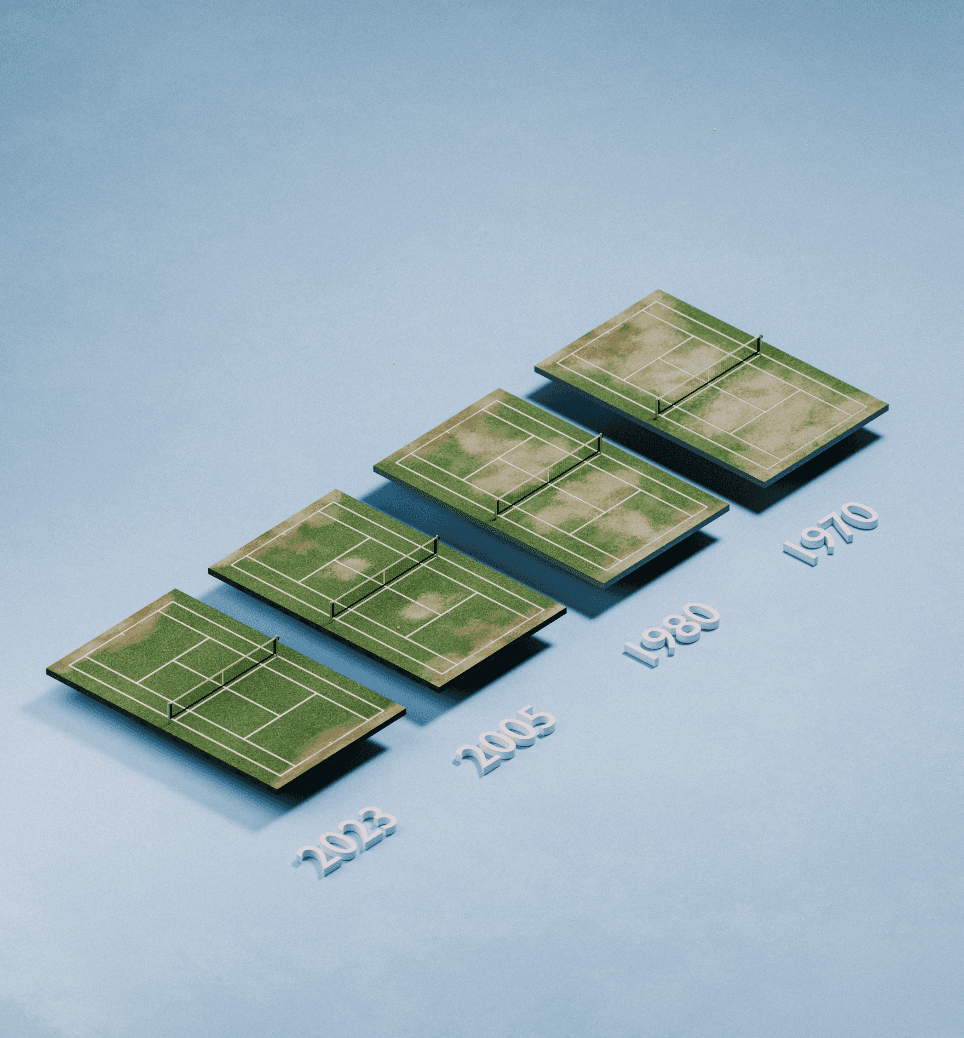P. Høpner
Oct 1, 2024
Tennis Courts & Organizational Change
How cause and effect sometimes confuse us and how studying the development of the wear patterns on Wimbledons Center Court can tell us a story about change and human behaviour.
Wear Patterns as Data Points
The other day, I came across a fascinating data visualization comparing the grass on Wimbledon’s Center Court over time. In images from the 1970s, the court looks worn, with large patches of brown where the grass has been beaten down. By 2023, however, the grass appears much greener, healthier, and more uniform. At first glance, the logical conclusion is that this improvement is due to better turf management. But when you dig a little deeper, it tells a much more interesting story.
You see, the real reason for this shift isn't found in the way the grass is cared for but in how the game itself has evolved. Over the decades, changes in racket technology and playing style have fundamentally altered how tennis is played. Wooden rackets, which were heavier and more difficult to control, led to a "serve and volley" style, with players moving quickly to the net. Today, with lighter, more powerful rackets made from materials like carbon fiber and graphite, players are stronger, and their style of play has shifted toward aggressive baseline rallies, with less need to approach the net.
Wimbledon’s Center Court, in this sense, acts like a living data visualization—a physical, organic map of how the sport has changed over time. And this evolution is not just a fascinating story about tennis; it offers a powerful metaphor for how we communicate and implement strategies in organizations. But how far can we take this approach? Could stories and visual metaphors be the key to making complex organizational changes feel more personal and relevant to the people affected by them? Could they help bridge the gap between high-level strategy and everyday operations in a way that makes change less intimidating and more tangible? My idea is that by exploring this approach we could unlock better ways to engage people in the process of adapting to evolving strategies—ways that are not only more effective but also more human. But first, let’s take a closer look at Wimbledon’s Center Court and how it has evolved into a living map of behavioral change.
Here you can see a visualization of how the Center Court of Wimbledon have changed over time. In the first frame the wear is evenly distributed over the entire court. But as years go by the wearpatterns become more intense at the end of the court.
So, why this fixation on the wear patterns of a tennis court? The way I see it the wear patterns on Wimbledon's Center Court are more than just marks on the grass; they are a tangible testament to the shifts in strategy, the advancements of technology, and the evolving skills of people. It bears witness to the passage of time, marking perpetual evolution and offering a creative and concrete way to convey change and transformations more broadly. To me, stories like these are at the heart of effectively communicating and talking about change. It’s about the hook of the story. In our professional lives, we're constantly inundated with abstract, high-level information at work about how business needs to transform, how we need to put people at the center of change and adapt to enter new market.
I believe that to truly engage people in change, we need to communicate in more concrete, relatable and fun ways, using well thought out storytelling to help connect with the message. I believe that by oddly introducing a completely different topic, like tennis, into conversations about strategy, we can cut through the usual noise that often surrounds discussions of strategy and change methodologies. When change strategies are implemented, it’s largely about making narratives and communication stick, as messages are distributed across large networks of people who already have many other things to manage in their lives. So, why not help ourselves by helping people remember the message better? Strong metaphors and visuals, like the changing patterns on Wimbledon's Center Court, can be powerful tools in this process. They have the potential to catalyze conversations in their inclusive nature of relatable topics as drivers and therefore bridge the gap between abstract ideas and everyday experiences.
And the data shows that this is an underdeveloped discipline. In Deloitte’s Human Capital Trends 2024, a significant theme emerges: the role of play and experience in driving human performance. Yet, despite the potential, only 41% of executives are taking action, with just 10% truly excelling in this area. There's an untapped frontier here, to engage people more deeply in their work by utilizing more playful methodologies. We could in many ways learn from the way children approach the world through play, games, and curiosity. These simple games are more than just fun—they’re how we start to internalize complex ideas. A child drawing their family with chalk on the sidewalk isn't merely playing; they’re learning about relationships and roles. Likewise, a game of cops and robbers, while seemingly innocent, introduces concepts of authority and justice. Through play, we begin shaping our understanding of society long before we realize it.
“Organizations will need digital playgrounds - safe spaces that encourage intentional play and curiosity - to experiment and explore new ways of working.”
When we bring play into the workplace, we lower the barriers to innovation and change, foster a deeper understanding of our colleagues’ perspectives, and uncover possibilities that might otherwise remain hidden. Just as children navigate the world through play, so too can we approach new technologies and changes with a sense of curiosity and exploration. In Deloitte’s repport it is noted that, “Technological advancement (…), is creating the potential for new ways of working that can help elevate human performance. To deliver on these outcomes, organizations will need digital playgrounds—safe spaces that encourage intentional play and curiosity—to experiment and explore new ways of working.” (Deloitte, 2024). In my approach to change and human behavior, I find that these principles are not just applicable but essential in organizational settings. The tools I’ve employed in my work are primarily visual, driven by the belief that messages are more powerful—and more quickly understood—when conveyed through engaging, accessible means.
Frameworks & Tennis Courts
Taking this back to the story of Wimbledon’s Center Court. On the surface, it’s a narrative about the evolution of a sport. But beneath that, it serves as a way we can better understand key organizational elements like people, processes and technologies.
People: In the same way that tennis players have evolved, becoming stronger and more strategic, organizational success depends on the continuous development of the people. Their skills, adaptability, and ability to leverage new technologies are crucial. The evolution of player tactics in tennis mirrors how our workforce must evolve to meet new challenges and opportunities.
Process: The players movement on the court tell a story about the strategy and tactics deployed in the game and show us how the process of the game has shifted. Just as the shift from net play to baseline rallies reflects a change in how tennis is played, organizational processes must adapt to new strategies and technologies. The way we approach our work, optimize our workflows, and execute our strategies must evolve to stay competitive, much like how tennis strategies have changed with advancements in the game.
Technology: Just as advancements in racket technology have transformed the game of tennis, the technologies at our disposal in organizations drive performance and shape outcomes. Modern tools, systems, and innovations empower us to work more efficiently and achieve results that were previously unimaginable.
Lowering The Entrypoint For Talking About Strategy
This is one way of telling a story about different perspectives in an organizational setting. You have probably seen an analysis like this, but in another form when you have discussed strategy and analyzed behavior in your organization: The PPT-Framework. The PPT framework (People, Process & Technology) serves as a lens through which we can view organizations and their moving parts. So, I did not invent the wheel here, but I gave you a story and a narrative to attach the content of strategic aspects to our daily work lives.
Can these stories go beyond simply illustrating change—can they actually become the catalyst for driving engagement, for making the need for change not just understood but felt on a deeper level by everyone in an organization? As I explore the dynamics of human behavior in organizational settings, I’m particularly interested in how leaders can use this approach in settings like town hall meetings, srategy formulations and workshops. When leaders weave strategies into strong metaphors or narratives, employees are more likely to remember and internalize those messages. A well-crafted story can make abstract strategies feel relatable and engaging, fostering a deeper connection to the change being introduced. Additionally, introducing more playful approaches in the workplace could not only encourage creativity but also make the process of adapting to new strategies more memorable and enjoyable.
However, I’m also aware there’s a fine line between impactful storytelling and slipping into clichés. It’s important to be mindful of how this approach is used, ensuring that the stories feel authentic and relevant, rather than forced. The question is: How do we make these stories tangible enough to inspire real action and transformation in our daily work without falling into the trap of overused metaphors?
This is the first in a series of essays called "Stories at Work," where I invite you to explore the deeper layers of human behavior and organizational change. My aim is to demystify the often abstract language of organizational behavior, turning it into something tangible and relatable. Through stories, illustrations, and visuals, we’ll uncover the power of networks, how to inspire people, and much more. These essays are designed to make the complex world of work more engaging and easier to understand. And who knows? Perhaps, in the end, we’ll discover that what unfolds in the executive suite is not so different from a game of tennis.




